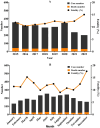Epidemiological analysis of 2,368 pesticide poisoning patients in Quzhou City, China
- PMID: 40520281
- PMCID: PMC12164162
- DOI: 10.3389/fpubh.2025.1587271
Epidemiological analysis of 2,368 pesticide poisoning patients in Quzhou City, China
Abstract
Introduction: Pesticides, which are chemical compounds, are mainly utilized to eradicate pests such as insects, rodents, fungi, and unwanted plants (weeds). However, improper application or storage of pesticides can lead to poisoning incidents. In China, many patients tend to abandon treatment and return home when their condition severely deteriorates. This behavior makes it challenging for medical institutions to precisely track the patients' subsequent conditions, resulting in the reported number of deaths in the system being lower than the actual figure.
Methods: This research obtained case data on pesticide poisoning in Quzhou city from 2015 to 2022 (2,368 confirmed cases) from ODSRS, using patient ID card numbers on the report cards to match cause-of-death data in the Zhejiang Chronic Disease Monitoring Information Management System. Excel 2013 was used for database establishment, Graph Prism 9.5.0 for statistical analysis and graphing, and ArcMAP10.2 for creating regional distribution maps. The chi-square test compared categorical variable groups; binary logistic regression explored factors influencing pesticide poisoning mortality.
Results: From 2015 to 2022, a total of 2,368 pesticide poisoning cases were documented in Quzhou City, exhibiting a downward trend. Among them, 280 patients died, with a case-fatality rate of 11.82%. The fatality rate was higher in males (13.35%) compared to females (10.03%), and it increased with age. Insecticides were implicated in 66.05% of the poisoning cases, followed by herbicides (20.82%) and rodenticides (9.71%). Notably, herbicides had the highest fatality rate at 15.21%. Non-occupational poisoning accounted for 91.01% of the cases, with suicidal poisoning constituting 65.57% and having a fatality rate of 15.07%. Statistically significant differences were observed in the distributions of fatalities across different genders, age groups, pesticide types, and causes of poisoning (p < 0.05). Pesticide poisoning was reported in all six counties of Quzhou City, with Kaihua County having the highest incidence, mortality, and case-fatality rate.
Conclusion: This study indicates that the actual fatality rate of pesticide poisoning patients is substantially higher than the reported rate. Additionally, being male, over 40 years old, and having non-occupational exposure to herbicides were associated with higher death odds ratios.
Keywords: fatality; herbicides; non-occupational; pesticide; poisoning.
Copyright © 2025 Zheng, Zheng, Wang, Jiao, Jiang, Lai and Zhan.
Conflict of interest statement
The authors declare that the research was conducted in the absence of any commercial or financial relationships that could be construed as a potential conflict of interest.
Figures





Similar articles
-
[Epidemiological analysis for Quzhou pesticide poisoning of year 2008 to 2010].Zhonghua Lao Dong Wei Sheng Zhi Ye Bing Za Zhi. 2012 Sep;30(9):676-8. Zhonghua Lao Dong Wei Sheng Zhi Ye Bing Za Zhi. 2012. PMID: 23257092 Chinese.
-
[Epidemiological characteristics of pesticide poisoning in Chengdu City from 2012 to 2021].Zhonghua Lao Dong Wei Sheng Zhi Ye Bing Za Zhi. 2023 Jun 20;41(6):451-456. doi: 10.3760/cma.j.cn121094-20220125-00049. Zhonghua Lao Dong Wei Sheng Zhi Ye Bing Za Zhi. 2023. PMID: 37400408 Chinese.
-
[Analysis of reports of cases of pesticide poisoning in Jiangsu Province, China, from 2006 to 2013].Zhonghua Lao Dong Wei Sheng Zhi Ye Bing Za Zhi. 2015 Mar;33(3):194-8. Zhonghua Lao Dong Wei Sheng Zhi Ye Bing Za Zhi. 2015. PMID: 25916445 Chinese.
-
The global distribution of acute unintentional pesticide poisoning: estimations based on a systematic review.BMC Public Health. 2020 Dec 7;20(1):1875. doi: 10.1186/s12889-020-09939-0. BMC Public Health. 2020. Retraction in: BMC Public Health. 2024 Oct 9;24(1):2758. doi: 10.1186/s12889-024-20318-x. PMID: 33287770 Free PMC article. Retracted.
-
Case Fatality as an Indicator for the Human Toxicity of Pesticides-A Systematic Scoping Review on the Availability and Variability of Severity Indicators of Pesticide Poisoning.Int J Environ Res Public Health. 2021 Aug 5;18(16):8307. doi: 10.3390/ijerph18168307. Int J Environ Res Public Health. 2021. PMID: 34444056 Free PMC article.
References
-
- World Health Organization . Chemical safety: pesticides. (2023). Available online at: https://www.who.int/news-room/questions-and-answers/item/chemical-safety... [Access February 13, 2024].
MeSH terms
Substances
LinkOut - more resources
Full Text Sources
Medical

